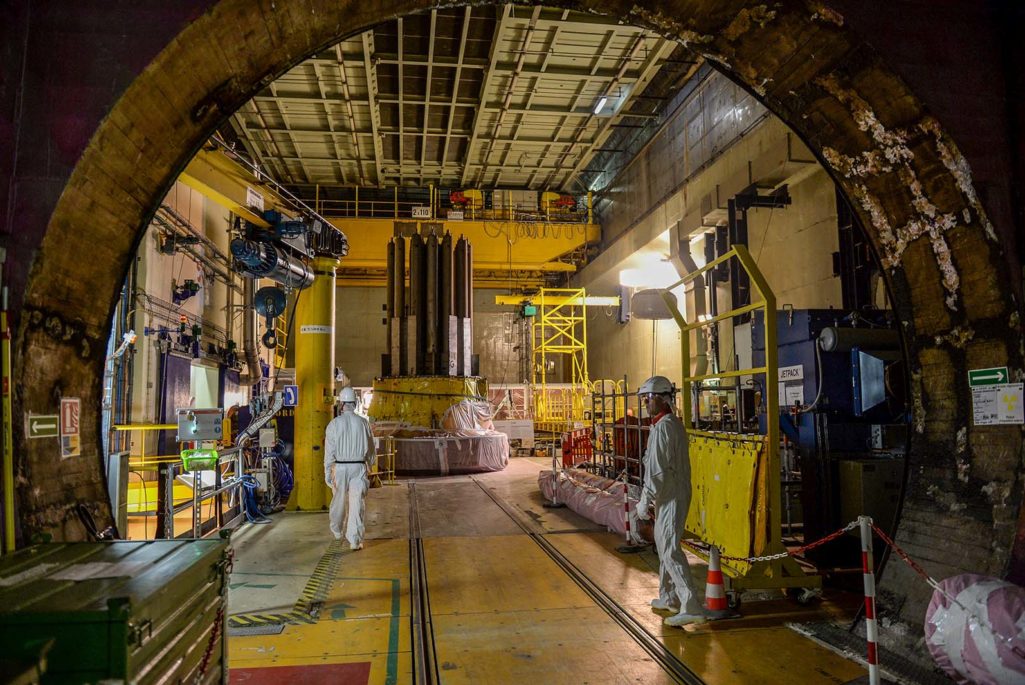Deconstructing a Different Kind of ‘Nuclear Spill’

Employees walk in the main room beside the lid of the nuclear reactor core (C) in Chooz, northern France, where the dismantling of the underground nuclear power reactor is entering its final phase.
Photo: Francois Lo Presti/AFP/Getty Images
Just as technology from space travel has spilled into our kitchens and garages, a sort of “nuclear spill” is going on, too. The process of nuclear decommissioning, and the methodology behind developing adequate funding where regulators and civil society opinion allow no slack, can find application in many energy and industrial contexts.
Planners of new nuclear projects are obsessed with detail. Investors, equipment manufacturers, plant operators and regulators alike leave nothing to chance. Nuclear safety and ensuring returns on investment drive the rigor; every aspect of the planning, construction, operation and ultimately dismantling is defined, configured, integrated and stress tested beyond doubt.
Construction period and cost overruns, for which new nuclear projects are well-known, have usually been due to inadequate definition of design and construction methodologies or the application of yet more layers of regulatory attention.
Decommissioning is an important part of this rigor; detailed plans need to be made about how it will be carried out, what the timing is, what the costs will be and how those costs will be funded. The focus on decommissioning is relatively recent; a consequence of legacy costs passed to the present generation from past decades, when environmental and regulatory considerations were less stringent. Action needs to be taken today on behalf of future generations.
The job is simple to define, but devilish to execute: Model the expected decommissioning costs annualized over the decades necessary to complete the process, understand the volatilities in the model, and then match a funding plan to optimize the investment returns while retaining enough flexibility in the cash-out period to allow for the volatilities.
The world is full of infrastructure where the future decommissioning is unfunded or underfunded. Power stations, oil rigs, mines, and even solar farms will need to be removed sooner or later, and future costs on balance sheets will embarrass managers and disgruntle shareholders. In some cases, the costs won’t be met, and the infrastructure will rot and rust until the taxpayer steps in.

Locations of nuclear power reactor sites undergoing decommissioning in the U.S.
Source: U.S. Nuclear Regulatory Commission
Finding Funding for the Long Run
Fortunately, few decommissioning tasks are as lengthy or as complicated as nuclear projects so the first part of the job is simpler; the annualized decommissioning cost model will be more straightforward and less volatile. But the second part, matching a funding mechanism for existing assets, will often have the additional complexity of a short (or even nonexistent) residual life during which revenue can be harvested to feed the fund. In these circumstances, the optimization of the fund resources, including top-ups needed to meet the overall projected costs, becomes even more important to protect shareholders from shouldering costs from the past and managers from having to plunder current revenue.
In many cases a portfolio can be constructed, so the funding flexibility is improved. Putting together future decommissioning obligations, at different times and for different asset types, enhances the fund manager’s options to keep more assets locked into better returns for a longer period of time. In some cases existing funds or vehicles, for example, captive insurance companies, can be used to create an integrated funding solution that leaves fund security intact but improves investment returns and long-term financial sustainability.
What goes up must come down. The need to decommission should be entirely predictable from the outset of any infrastructure project. But more often than not, the costs are underestimated: The now defunct UK Department of Energy and Climate Change estimated that oil and gas decommissioning costs on the UK Continental Shelf, on average, are 40 percent over budget. The unpredictability extends to the timing, too, and schedules can be affected by events happening outside of an individual plant: In the aftermath of the Fukushima disaster, Germany declared the end of nuclear power in the country by 2022, foreshortening power plant life and hastening the decommissioning obligation.
Clever funding can take away some of the cash flow risk and improve the predictability of the annualized cost over a period, to the delight of CFOs. But what about the truly unpredictable risks?
What if adverse circumstances occur notwithstanding the diligent investigation and planning of the owner of the assets? Such risks are the domain of the insurance industry. Insurers will steer clear of insuring against inadequate planning (although they can cover consequent material damage or liabilities). They will thrive on the unexpected and, in an industry awash with capital, are keen to deploy capacity in new areas.
So far the insurance solutions offered to protect against unexpectedly onerous decommissioning costs are few and the market is immature. Insurers should watch this space: The constraint is ripe for dismantling.




